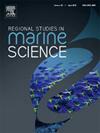Sediment transport and heavy mineral distribution along the Bavanapadu-Nuvvalarevu shelf, East Coast of India: Implications for coastal Morphodynamics
IF 2.1
4区 环境科学与生态学
Q3 ECOLOGY
引用次数: 0
Abstract
Offshore sediment transport and mineral dispersal remain less understood compared to coastal settings, despite their importance for geological and resource studies. Unlike previous studies that focused primarily on coastal sediment transport, our research extends offshore, revealing complex interactions between riverine and marine influences. This study provides new insights into sediment transport and heavy mineral distribution along the Bavanapadu–Nuvvalarevu shelf, East Coast of India, by integrating offshore sediment core analysis. Grain-size analysis indicates a transition from medium to fine sand at the surface, with silt and clay dominating subsurface layers, suggesting fluctuating energy conditions. CM diagrams and Pejrup M-triangle plots confirm a river-dominated depositional environment with beach influences, where marine currents contribute to sediment redistribution. Total Heavy Mineral (THM) content across four depth intervals (0.00–4.00 m) shows a consistent decline with depth, with the highest concentrations (1.056–9.667 wt%) in the uppermost layer, decreasing progressively to 0.210–4.417 wt% at 3.00–4.00 m. The study also reveals that heavy mineral concentration is lowest in the coarse (-35 + 60), higher in medium (-60 + 120), and highest in the fine (-120 + 230) fractions. Heavy mineral analysis reveals a decline in concentration with depth, with magnetite, ilmenite, and garnet being most abundant in fine sand, highlighting the role of hydrodynamic sorting. These findings enhance our understanding on offshore placer mineral deposition and sediment redistribution, offering valuable implications for shoreline management and resource exploration. Understanding these dynamics is essential for sustainable coastal planning and the long-term assessment of India’s offshore mineral wealth.
印度东海岸巴瓦纳帕杜-努瓦拉雷武陆架沉积物运输和重矿物分布:对海岸形态动力学的影响
尽管对地质和资源研究具有重要意义,但与沿海环境相比,对近海沉积物运输和矿物扩散的了解仍然较少。与以前主要关注沿海沉积物运输的研究不同,我们的研究扩展到近海,揭示了河流和海洋影响之间复杂的相互作用。本研究通过整合近海沉积物岩心分析,为研究印度东海岸巴瓦纳帕杜-努瓦拉雷武陆架的沉积物运移和重矿物分布提供了新的见解。粒度分析表明,表层由中砂过渡到细砂,次表层以粉砂和粘土为主,表明能量条件波动。CM图和Pejrup m -三角形图证实了受海滩影响的河流主导的沉积环境,其中海流有助于沉积物的再分配。4个深度层(0.00-4.00 m)的总重矿物(THM)含量随深度呈下降趋势,最上层的THM含量最高(1.056-9.667 wt%),在3.00-4.00 m处逐渐下降至0.210-4.417 wt%。研究还表明,重矿物浓度在粗粒级(-35 + 60)中最低,在中粒级(-60 + 120)中较高,在细粒级(-120 + 230)中最高。重矿物分析显示,细砂中磁铁矿、钛铁矿和石榴石的含量随深度的增加而下降,突出了水动力分选的作用。这些发现增强了我们对近海砂矿沉积和沉积物再分配的认识,为岸线管理和资源勘探提供了有价值的启示。了解这些动态对于可持续沿海规划和对印度近海矿产财富的长期评估至关重要。
本文章由计算机程序翻译,如有差异,请以英文原文为准。
求助全文
约1分钟内获得全文
求助全文
来源期刊

Regional Studies in Marine Science
Agricultural and Biological Sciences-Ecology, Evolution, Behavior and Systematics
CiteScore
3.90
自引率
4.80%
发文量
336
审稿时长
69 days
期刊介绍:
REGIONAL STUDIES IN MARINE SCIENCE will publish scientifically sound papers on regional aspects of maritime and marine resources in estuaries, coastal zones, continental shelf, the seas and oceans.
 求助内容:
求助内容: 应助结果提醒方式:
应助结果提醒方式:


